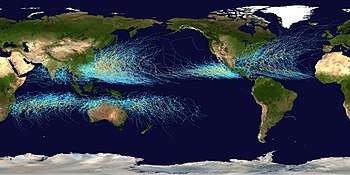Freezing drizzle
Freezing drizzle is drizzle that freezes on contact with the ground or an object at or near the surface. Its METAR code is FZDZ.[1]
| Part of a series on |
| Weather |
|---|
 |
|
|
Formation
Although freezing drizzle and freezing rain are similar in that they both involve liquid precipitation at the surface in subfreezing temperatures, the mechanisms leading to their development are entirely different. Where freezing rain forms when frozen precipitation falls through a melting layer, freezing drizzle forms via the supercooled warm-rain process, in which cloud droplets coalesce until they become heavy enough to fall out of the cloud.[2] Despite this process taking place in a subfreezing environment, the liquid water will not freeze if the environmental temperature is above 18 °F (−8 °C).[3] If ice crystals are already present in this environment, the liquid droplets will freeze onto these crystals and be effectively removed before they can grow large enough to fall out of the cloud. As a result, freezing drizzle develops in shallow stratus-type clouds where saturation occurs entirely below the layer in which ice crystals can develop and grow.[2]
Effects
When freezing drizzle accumulates on land, it creates an icy layer of glaze. Freezing drizzle alone does not generally result in significant ice accumulations due to its light, low-intensity nature. However, even thin layers of slick ice deposited on roads as black ice can cause extremely hazardous conditions resulting in vehicle crashes.
Freezing drizzle is extremely dangerous to aircraft, as the supercooled water droplets will freeze onto the airframe, degrading aircraft performance considerably. The loss of American Eagle Flight 4184 on October 31, 1994, has been attributed to ice buildup due to freezing drizzle aloft.[2]
See also
References
- Spence, Charles F. (2006). Aim/Far. McGraw Hill Professional. p. 294. ISBN 9780071479240. Retrieved 13 October 2017.
- Rauber, Robert M; Walsh, John E; Charlevoix, Donna Jean (2012). Severe & Hazardous Weather. ISBN 9780757597725.
- "Freezing Drizzle on January 26th; A Look Into Why". National Weather Service. Retrieved 10 December 2017.